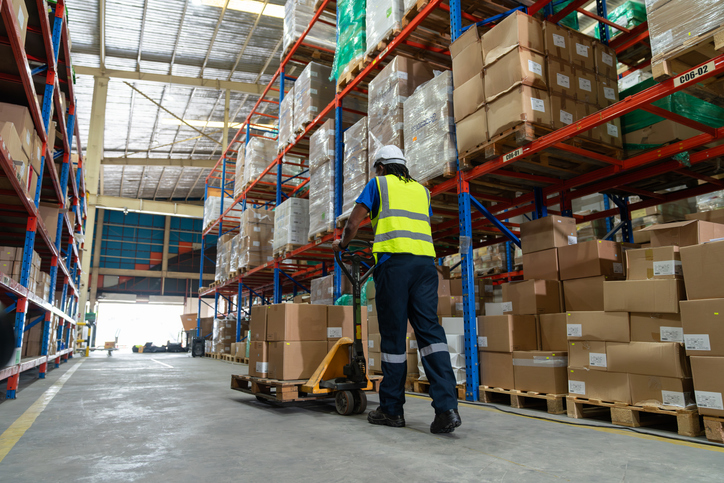Efficiency is critical for warehouses and distribution centers, and that applies to every operational process—including recycling. An efficient recycling plan can save your facility time, money, manpower, and space. Maximizing warehouse recycling efficiency often involves making a few minor adjustments to the way you’re currently doing things. And for new warehouses and distribution centers, implementing an efficient recycling process should happen before operations begin. In a high-volume facility, any breakdown of the waste management system can quickly become a significant problem.
Warehouse Recycling Efficiency: 4 Key Objectives for Large Facilities
- Maximizing space.
Bringing in the right mix of containers and recycling equipment is vital to warehouse recycling efficiency. With too few collection containers on site, waste piles up and becomes an unsightly potential safety hazard. On the flip side, too many onsite recycling containers take valuable square footage, and they could get in the way of workers and machinery. There’s a careful balance to strike.
Then there’s the question of commercial recycling equipment, such as balers and compactors. These pieces of equipment are a huge asset in warehouses, distribution centers, grocery stores and other facilities that generate a lot of cardboard and other waste. But many facilities could use on-site recycling equipment more efficiently. They may be using machines that are too small for their needs, or too large for the space. Sometimes, improving warehouse recycling efficiency can be as simple as bringing in an additional baler or rearranging the layout of the facility’s recycling equipment. Every site is unique, so figuring out the best way to maximize recycling space varies by case.
- Collecting all the right materials, in the right places.
Achieving this objective is largely about getting employees to comply with the workplace recycling program. The workers who move through the facility decide where to dispose of waste, so you can’t improve warehouse recycling efficiency without their buy-in.
Container placement and employee training are two places where employers can focus their efforts. The goal is for all workers to know what can be recycled vs. what can’t be recycled, and that it’s easy for them to get the right materials into the right containers. The more you can do to prevent contamination, the better. (Contamination describes any time something is mixed into a load of recyclable materials, but it can’t be processed with those materials. For example, in a bin that’s designated for recycling empty plastic bottles, a glass bottle and a plastic bottle that still has soda inside would both be contaminants.)
In a warehouse setting, observing workflow and the habits of the workforce are really critical for determining where different kinds of collection containers should be placed. It requires looking at things like, what kinds of materials are being disposed of in different areas of the facility? Would a worker on their first day be able to look around their work area and know where to dispose of trash vs. something recyclable? Has the organization explicitly trained employees about what kinds of materials are recyclable? In a large facility like a warehouse, it’s reasonable to expect that some portion of the workforce won’t think about recycling unless it’s one of their job duties.
- Limiting costs and maximizing returns.
Improving sorting and bringing in the right equipment are already two key ways to improve the cost effectiveness of a warehouse recycling program. Capturing all your recyclable material, while reducing contamination in your containers, helps your organization get the best possible price for any valuable materials you collect. Make sure to consult with your recycling provider about more specific ways to maximize returns on the scrap metal, mixed paper, and other valuable materials your facility generates.
Having adequate equipment to manage a high volume of waste also helps you control costs with your recycling provider. Using compactors and balers efficiently to condense clean corrugated cardboard and other types of waste might mean you can schedule less frequent pickups, compared to a facility that collects waste in dumpsters.
- Having a plan for hard-to-manage waste.
If your facility handles organic material, you should already have policies for disposing of organic waste. Same with hazardous materials, or anything else that can’t be landfilled or shredded safely. Assuming you have those policies in place, are you clear about what they say? Do managers and workers know what materials require special handling, and where they should be collected? Are you clear about your regulatory responsibilities under laws like the Massachusetts organic waste ban? For optimal efficiency, facility managers need to be proactively prepared to manage the disposal of any material. Time can be wasted while people scramble to figure out solutions for hard-to-recycle materials.
Need Help Improving Warehouse Recycling Efficiency?
Miller Recycling works with warehouses, distribution centers, grocery stores, and other high-volume businesses to design customized recycling systems. We can walk through your site with you and make recommendations based on your space, needs, and budget. Miller Recycling can also bring in recycling equipment like compactors and balers, provide collection services, advise you on hard-to-manage waste, and more. Contact me today!


